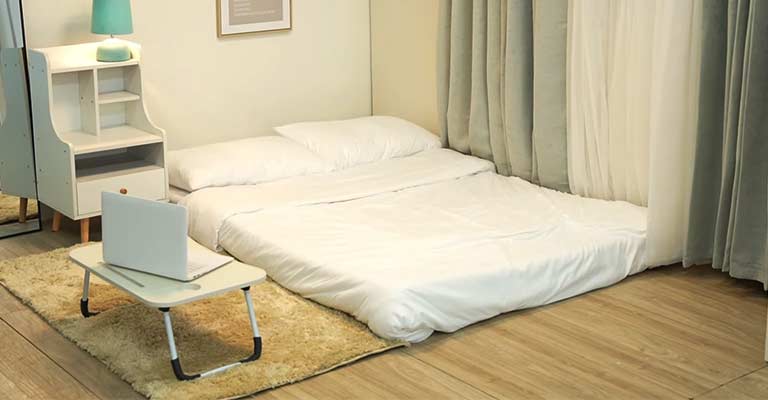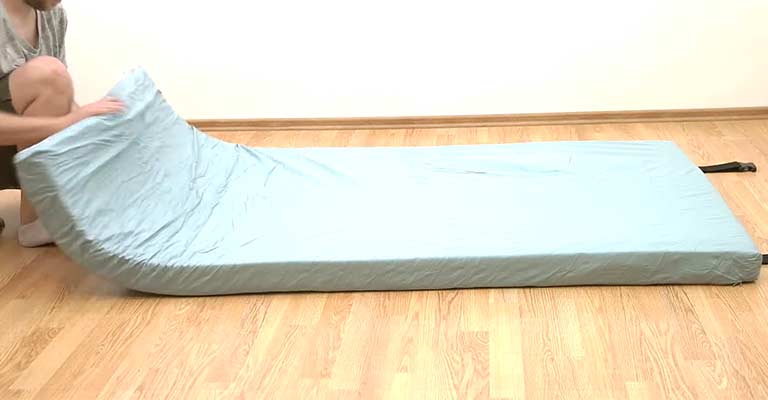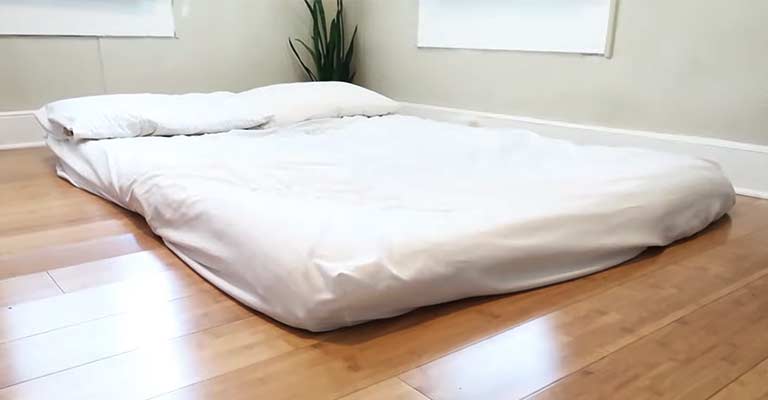Yes, a mattress can be placed on the floor. There are many advantages to placing the mattress on the floor, such as excellent support, cost savings, and a clean aesthetic.
Placement on the ground, however, also exposes the mattress to possible warranty, hygiene, and performance issues. Mattresses that are placed on the floor are more convenient for many people.
Taking this route is the most cost-effective – but it’s not always the best choice. According to some, the best way to place a mattress is directly on the floor, but the question of whether or not they should be placed there is entirely up to you.
As far as I am concerned, placing mattresses on the floor is not a major issue. The downsides of this approach are, however, significant. Below, you’ll find pros, cons, and tips on how to best set up the mattress.
Types of Mattresses You Can Put on the Floor
There are several types of mattresses specifically designed for floor use, without supporting systems or bed frames:
Rolling Mattress
The idea behind rolling mattresses is that you can roll them up when they are not in use so that you can store them in your closet.
In addition to being relatively thin and compact, they are easy to store. Foam mattresses are often used for camping, and they can be made of a variety of materials.
Folding Mattress
For easy storage, folding mattresses fold up into thirds and fourths and are usually made of high-density polyurethane or memory foam.
It is helpful to have these beds available for guests, especially children, as they can be put on the floor.
Your foldable bed should come with a machine washable or allergen-resistant cover to ensure its cleanliness and comfort.
Air Mattress
After you wake up in the morning, you can deflate, fold, and tuck away your air mattress that you inflated with air.
The cost of an air mattress is relatively low, and if you use it properly, it will last up to six years. Using them frequently will lead to faster wear down, since they aren’t designed for extended use.
Some sleepers will find these beds to be suitable permanent beds, although they are mostly intended for guests or children.
You don’t need to use a box spring, foundation, or bed frame to set them up, and they are extremely easy to assemble.
The Benefits Of A Floor Mattress

There are a number of reasons why you might think it is a good idea to put your mattress on the floor. In particular, if you just purchased a new mattress and are eager to put it to use.
Moreover, there are a few really nice advantages. You can benefit from directly placing your mattress on the ground in the following ways.
Takes Up Less Space
There’s no denying that a bed on the floor is always going to take up less space than one on a platform or bed frame.
The room will visually lighten, and the bed will appear less prominent, though it won’t give you a large walkable footprint.
It may be the best design aesthetic for you to put your bed on the floor, especially if you have a very small space.
Can Save Money
The cost of a new mattress can be quite high. If you add the cost of a box spring/foundation and a bedframe, it could add up to a lot of money that you aren’t prepared to spend.
When you place your mattress directly on the ground, you will save money and reduce the amount of shopping you have to do.
May Improve Blood Circulation
Your heart works less hard to circulate the blood when you have good posture and spinal alignment. Consequently, the heart is less stressed and blood flow is improved.
May Reduce Back Pain
When you place your mattress on the floor, it may feel firmer than it does on a conventional bed frame. In addition to reducing back pain, this extra firmness can also improve posture.
Exactly how does it work? As a result of sleeping on the ground, you receive a more consistent support between the edges of your mattress.
There is no slat, metal, or wood support structure between the mattress and the floor (as opposed to slats, metal, or wood support structures).
By doing so, you can maintain a neutral spine and neck position and improve your posture at the same time.
The Risks Associated With A Mattress On The Floor

It isn’t always a no-brainer to place your mattress on the floor, even with the possible benefits listed above. You should also consider certain cons and considerations in addition to the pros.
Dust And Dust Mites
Obviously, dust and dust mites must be mentioned first. For some sleepers, especially those with allergies, this can be a dealbreaker.
You shouldn’t have any separation between your mattress and the floor (e.g., mattress protector, area rug, etc.) because dirty floors can be a breeding ground for allergens and debris.
It is common to find dust mites nestled inside mattresses, rugs, carpets, and curtains, as they feed on dead skin cells.
Dust mites may not affect every sleeper, but if you are sensitive to them, you may experience the following symptoms:
- Hives
- Rashes
- Red, itchy eyes
- Congestion or difficulty breathing
- Sneezing
- Itching
Too Hot in Summer, Too Cold in Winter
The limited airflow of a mattress placed directly on the floor may make it difficult to maintain a comfortable temperature. The cooler temperature of the floor may cause your mattress to be very cold in the winter.
Also, because the mattress lacks airflow, it may become very hot in the summer. It might not be the best option for you to put your mattress on the floor if you are sensitive to heat and cold.
Not Ideal For Side Sleepers
The contours of a pillow that follows the natural curves of the body of a person who sleeps on their side are generally more comfortable.
The firmness of a mattress on a floor is generally greater than that of a mattress on a bedframe or foundation.
Side sleepers might find this extra firmness too much support, which prevents them from receiving adequate contouring support for their midsections.
Harder To Get In And Out Of
According to the height of the person, the ideal height for a bed is somewhere between 20 and 24 inches. There are about 12 inches of height in an average mattress, half the height of an average bed.
People suffering from chronic pain or aging adults may find it difficult to adjust to this mattress’ lower height. If your mattress is on the floor, it will be harder to get in or out of bed.
Mold And Mildew
The humidity / moisture inside a mattress can increase due to poor airflow when your mattress is on the floor. Mold and mildew can develop wherever there is humidity.
Depending on how sensitive you are to the allergen, mold and mildew can cause mild to severe health risks.
A stuffy nose, wheezing, red or itchy eyes, and skin irritation are all mild mold exposure symptoms.
It is possible, however, that other more serious symptoms may develop if the exposure continues. It is also possible to experience fatigue, nervous disorders, headaches, loss of appetite, or brain damage as more concerning symptoms.
Tips For Putting Your Mattress On The Floor

Following a careful consideration of the pros and cons of putting your mattress on the floor, here are some tips for getting started.
Use A Mattress Protector
There is no doubt that a mattress on the floor has a higher likelihood of attracting creepy crawlies than one 12 inches off the ground.
The best way to protect your mattress from dust mites, allergens, and even bed bugs is to add a mattress protector or encasement.
Mattress Protector vs. Mattress Encasement
Protectors and encasements differ in the number of sides they have.
Usually, mattress protectors have five sides and fit like fitted sheets. Mattress encasements, however, are 6-sided and fit over the mattress like a pillowcase with a zipper.
It is vital to have an encasement on the bottom layer of the floor mattresses in order to ensure maximum protection.
Add A Barrier
It might be a good idea to put a barrier between the hard floor and the mattress if you really wish to put your bed on the floor.
There are a lot of inexpensive barriers you can use to prevent your mattress from sliding and transferring heat, debris, and allergens.
In addition, barriers don’t have to be expensive. Barriers that could be effective include:
- Boxspring
- Foam mat
- Blanket
- Cardboard
- Plywood
- Area rug
Avoid Foam Mattresses
Foam mattresses can definitely go on the floor, but many of them will not perform their best on the ground.
The majority of foam mattresses retain more heat by nature than coil mattresses and hybrid mattresses. Is there an exception to the rule? Yes, of course. An example of an exception would be:
- Mattresses with convoluted for perforated foam layers
- Latex foam mattresses
- Foam / coil hybrid mattresses
Add A Dehumidifier
Another way to prevent mold or mildew growth under your mattress is to add a dehumidifier to your room.
When it comes to keeping humidity under control, propping up the mattress is best for air flow, while using a dehumidifier when it comes to helping keep humidity down can be helpful.
Air It Out
The key to ensuring that air circulates under your mattress when it’s on the floor is to keep it off the ground for at least a few minutes each day.
You may want to consider propping your mattress up on its side on a regular basis to allow air to circulate beneath it.
The mattress will have a better chance of airing out, the humidity level will be lower, and mold and mildew will be less likely to be present.
FAQs
1. How To Stop My Bed From Sliding Or Rolling?
There is some movement associated with a mattress directly on the floor as compared to a mattress on a bed frame.
If you want to prevent this, consider placing a mat directly under your mattress or using rug pads that don’t slip. Your mattress could also be covered with a large area rug with a non-slip back for a better design choice.
2. What Goes Under A Mattress?
For a mattress to perform at its best, it needs to be supported at a certain level. There are some people who only need the support of the floor.
There are also mattresses that require a boxspring or foundation, like traditional innersprings or coil-on-coils.
Modern mattresses do not need boxsprings, but they may still be necessary if your frame does not provide adequate support. If you need additional support, consider a low-profile boxspring, bunkie board, or reinforced slat system.
3. Will Putting My Mattress On The Floor Void My Warranty?
Perhaps. Before putting your mattress on the floor, you should definitely check with the manufacturer. Some warranties are void if this happens, so if you try to make a claim down the road, it may not be covered.
4. Is It Okay To Put A Boxspring On The Floor?
Of course. Between your mattress and the floor, a traditional boxspring provides support and ventilation.
With this solution, you can put your mattress on the floor without being bothered by the aesthetics and cost of buying a conventional bed frame.
5. How High Should My Bed Be From The Floor?
Individual sleepers may have a preference for a mattress height between 20-24 inches high, but most people find a mattress between 20-24 inches high comfortable for most people.
The Bottom Line
You may want to consider putting your mattress on the floor if you want to save money and prefer a firm sleeping surface.
Ensure that sleeping without a foundation won’t void your mattress warranty, wrap your mattress in a protective cover, and keep your floor clean to ensure the quality of your mattress isn’t compromised.
Disclaimer: Information in this guide is intended solely for informational purposes and is not intended as medical advice. For medical advice, always consult your doctor.








